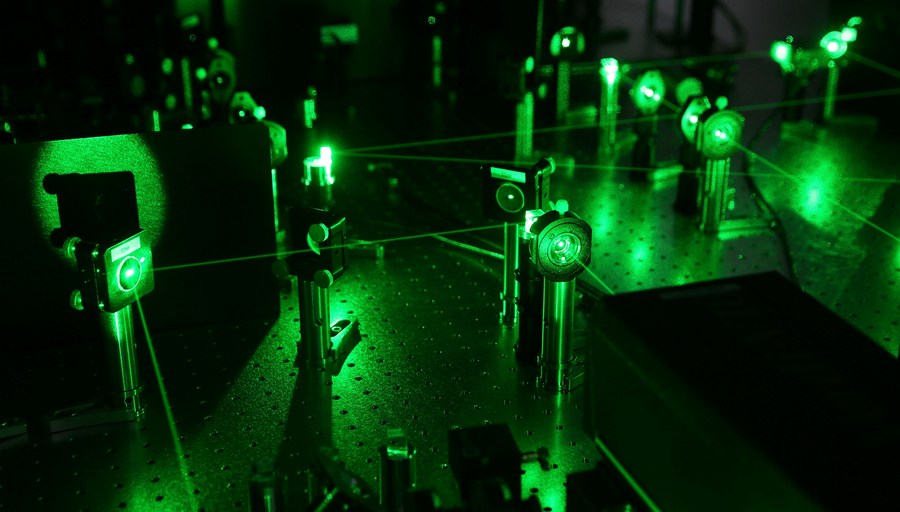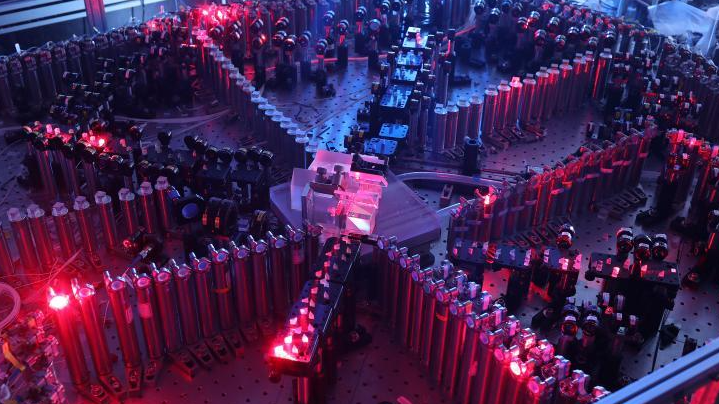
The quantum simulation laboratory of Chinese Academy of Sciences, in Shanghai, east China. /Xinhua
The quantum simulation laboratory of Chinese Academy of Sciences, in Shanghai, east China. /Xinhua
Editor's note: Djoomart Otorbaev is the former prime minister of the Kyrgyz Republic, a distinguished professor of the Belt and Road School of Beijing Normal University, and a member of Nizami Ganjavi International Center. This is the second piece of his series on quantum computers. The article reflects the author's views and not necessarily those of CGTN.
In three papers published on arXiv.org on June 28 and 29, scientists from the University of Science and Technology of China (USTC) reported fundamental advances in quantum communications and quantum computing.
In one, researchers used nanometer-sized semiconductors called quantum dots to transmit single photons over 300 kilometers of fiber. This result was more than 100 times better than all previous attempts.
In another, scientists improved their photonic quantum computer from 76 detected photons to 113, which significantly increased its "quantum advantage." It shows how much faster it is than traditional computers at one specific task.
The third paper presented the Zu Chongzhi quantum computer, consisting of 66 superconducting qubits. It used 56 of them to solve a particular problem, which exceeded the computational speed achieved by 53-qubit computers applied by Google Sycamore and set a performance record in 2019 .
"It's an exciting development. I did not know that they were coming out with not one but two of these [quantum computing results] in the same week," says Scott Aaronson, a theoretical computer scientist at the University of Texas at Austin. "That's pretty insane."
All three achievements are leading globally, but the experts are especially excited about Zu Chongzhi because this is the first confirmation and a significant excess of Google's Sycamore landmark result in 2019. "I'm very pleased that someone has reproduced the experiment and shown that it works properly," says John Martinis, a former Google researcher who led the effort to build Sycamore.
This year begins implementing China's 14th Five-Year Plan, which sets goals and strategies for the country's economic development until 2025. The plan resulted from joint action with the government's official political advisory body, the Chinese People's Political Consultative Conference (CPPCC). Renowned Chinese quantum physicist Pan Jianwei, a member of the CPPCC, said that the plan includes "major national scientific and technological projects in frontier fields including quantum information technology."

A research team including Chinese quantum physicist Pan Jianwei established a quantum computer prototype, named "Jiuzhang," via which up to 76 photons were detected, the team announced December 4, 2020. /Xinhua
A research team including Chinese quantum physicist Pan Jianwei established a quantum computer prototype, named "Jiuzhang," via which up to 76 photons were detected, the team announced December 4, 2020. /Xinhua
As part of this document, by the end of the 14th Five-Year Plan, it is planned to develop quantum computers with more than a few hundred qubits.
In December 2020, a research team led by Pan Jianwei announced another significant computing breakthrough, achieving quantum computational advantage. Scientists have created a new quantum computer, Jiuzhang, which computes 10 billion times faster than Google's Sycamore prototype. Compared to conventional computers, Jiuzhang is "a champion in a single field," according to the research team. Still, its super computing capabilities have enormous potential in graph theory, machine learning, and quantum chemistry. The breakthrough resulted from 20 years of effort by Pan's team, which conquered several major technological stumbling blocks, including a high-quality photon source.
There have been few other outstanding results in the field of quantum computing. In one example, a Chinese startup has announced plans to sell a quantum desktop computer for less than $5,000. The new handheld device is part of the SpinQ line and will be designed even for schools and colleges. Shenzhen SpinQ Technology will manufacture it. It was not the company's first quantum computer. Last year, it began selling a desktop quantum computer for about $50,000. The first sample was quite big and weighed 55kg, but the new machine will be simpler, more portable, and cheaper.
Unprecedented competition is unfolding in this area. Сhina is leading the way with a quantum program worth at least $10 billion over the next five years, of which $3 billion will go into quantum computing.
The U.S. House of Representatives passed the $1.275 billion National Quantum Initiative Act, complementing ongoing initiatives by the Department of Energy, the Office of Army Research, and the National Science Foundation.
The European Union has allocated $1.1 billion, and the UK $381 million in additional funding for quantum technology. Many other countries, especially Australia, Canada and Israel, are also very active.
Back in 2017, a group of Chinese scientists emitted entangled photons from the national satellite Micius to conduct the world's first quantum security video call. American experts immediately sounded the alarm that China had suddenly become a leader in the critical area of quantum communications.
In response, American politicians decided urgently to invest hundreds of millions of dollars in the development of quantum informatics through the National Quantum Initiative.
The current situation is reminiscent of what had developed in 1957 when the U.S. similarly launched an unprecedented development program for its space program in the wake of panic over a small Soviet satellite called Sputnik. Will Americans be able to repeat their leap for quantum advantage this time?
(If you want to contribute and have specific expertise, please contact us at opinions@cgtn.com.)

